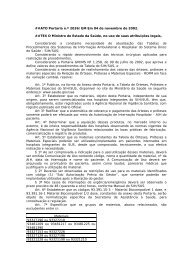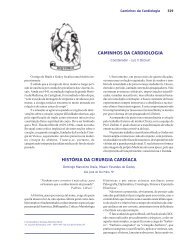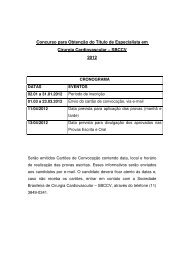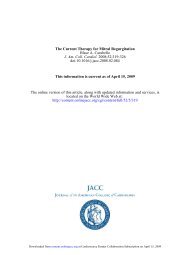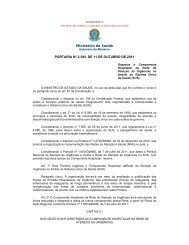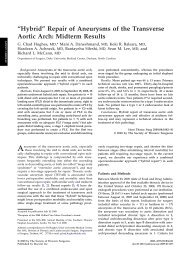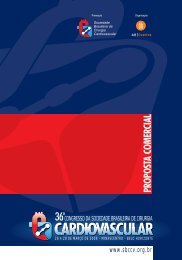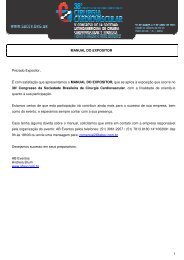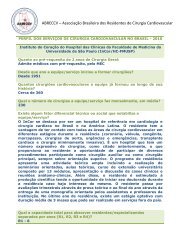Clopidogrel Increases Blood Transfusion and Hemorrhagic ...
Clopidogrel Increases Blood Transfusion and Hemorrhagic ...
Clopidogrel Increases Blood Transfusion and Hemorrhagic ...
Create successful ePaper yourself
Turn your PDF publications into a flip-book with our unique Google optimized e-Paper software.
ORIGINAL ARTICLES: ADULT CARDIAC<br />
CARDIOTHORACIC ANESTHESIOLOGY:<br />
The Annals of Thoracic Surgery CME Program is located online at http://cme.ctsnetjournals.org.<br />
To take the CME activity related to this article, you must have either an STS member or an<br />
individual non-member subscription to the journal.<br />
<strong>Clopidogrel</strong> <strong>Increases</strong> <strong>Blood</strong> <strong>Transfusion</strong> <strong>and</strong><br />
<strong>Hemorrhagic</strong> Complications in Patients<br />
Undergoing Cardiac Surgery<br />
Christine R. Herman, MD, Karen J. Buth, MS, Blaine A. Kent, MD, <strong>and</strong><br />
Gregory M. Hirsch, MD<br />
Division of Cardiac Surgery <strong>and</strong> Department of Anesthesia, Queen Elizabeth II Health Sciences Center, Halifax, Nova Scotia,<br />
Canada<br />
ADULT CARDIAC<br />
Background. Utilization of the irreversible antiplatelet<br />
agent clopidogrel is increasing in the treatment acute<br />
coronary syndrome patients. Consequently, more patients<br />
are presenting for urgent cardiac surgery with an<br />
irreversible defect in platelet function. The objective of<br />
this study was to determine whether recent clopidogrel<br />
administration predicts transfusion <strong>and</strong> hemorrhagic<br />
complication in cardiac surgery patients.<br />
Methods. This retrospective study included all patients<br />
undergoing isolated coronary artery bypass graft surgery<br />
(CABG), isolated valve, or CABG plus valve at a single<br />
center between 2004 <strong>and</strong> 2008. The outcomes of interest<br />
were transfusion <strong>and</strong> hemorrhagic complication. <strong>Clopidogrel</strong><br />
stop interval was defined as the time between last<br />
dose <strong>and</strong> presentation to the operating room, <strong>and</strong> was<br />
examined in daily increments from 0 to 5 days, more than<br />
5 days, <strong>and</strong> not receiving clopidogrel preoperatively. By<br />
logistic regression, the association of clopidogrel stop<br />
interval with transfusion <strong>and</strong> with hemorrhagic complication<br />
was examined after adjusting for other risk factors.<br />
Results. Of 3,779 patients included in this study, 26.4%<br />
(999) received clopidogrel preoperatively. The overall<br />
rates of transfusion <strong>and</strong> hemorrhagic complication were<br />
34.1% <strong>and</strong> 4.1%, respectively. <strong>Clopidogrel</strong> use within 24<br />
hours was an independent predictor of transfusion (odds<br />
ratio 2.4; 95% confidence interval: 1.8 to 3.3) <strong>and</strong> of<br />
hemorrhagic complication (odds ratio 2.1; 95% confidence<br />
interval: 1.3 to 3.6).<br />
Conclusions. Patients receiving clopidogrel within 24<br />
hours of surgery are at increased risk for transfusion <strong>and</strong><br />
hemorrhagic complication. Timing of surgery for patients<br />
receiving clopidogrel should take into account the<br />
interval from the last dose.<br />
(Ann Thorac Surg 2010;89:397–402)<br />
© 2010 by The Society of Thoracic Surgeons<br />
The effectiveness of clopidogrel in acute coronary<br />
syndrome is well established, with level 1 evidence<br />
indicating reduction in death <strong>and</strong> major morbidity in<br />
ST-segment elevation myocardial infarction, non–STsegment<br />
elevation MI, as well as a reduction in in-stent<br />
thrombosis after percutaneous coronary intervention<br />
(PCI) [1–6]. American Heart Association/American College<br />
of Surgery guidelines support the administration of<br />
clopidogrel in STEMI, NSTEMI, <strong>and</strong> before PCI [7–9]. As<br />
a consequence of these developments, more patients are<br />
presenting for urgent cardiac surgery having received<br />
clopidogrel.<br />
Several studies suggest cardiac surgical patients are at<br />
increased risk of adverse outcomes, transfusion, <strong>and</strong><br />
hemorrhagic complications when receiving clopidogrel<br />
Accepted for publication Oct 21, 2009.<br />
Address correspondence to Dr Hirsch, Division of Cardiac Surgery,<br />
Queen Elizabeth II Health Sciences Center, 1796 Summer St, Room 2006,<br />
Halifax, Nova Scotia, B3H 3A7, Canada; e-mail: ghirsch@dal.ca.<br />
preoperatively [10, 11], although these results are inconsistent.<br />
Karabulut <strong>and</strong> colleagues demonstrated no increased<br />
risk for transfusions or hemorrhagic complications<br />
in cardiac surgical patients receiving clopidogrel<br />
[12], whereas others have shown an increase in transfusion<br />
of two to four units on average [10, 13], <strong>and</strong> still<br />
others, including Ley <strong>and</strong> coworkers [14] have shown a<br />
tenfold increase in reexploration for tamponade. The<br />
potential for increased bleeding complications with clopidogrel<br />
extends to off-pump surgery as well [15].<br />
Cardiac surgery patients who experience significant<br />
postoperative bleeding or receive blood transfusions are<br />
at increased risk for other adverse outcomes. <strong>Blood</strong><br />
transfusions have been associated with increased rates of<br />
clinically significant infections, ischemic, <strong>and</strong> 30-day<br />
mortality [16]. Return to the operating room for bleeding<br />
complications has been identified as an independent<br />
risk factor for operative mortality, <strong>and</strong> nonfatal<br />
adverse outcomes [17].<br />
Given the adverse outcomes associated with blood<br />
© 2010 by The Society of Thoracic Surgeons 0003-4975/10/$36.00<br />
Published by Elsevier Inc<br />
doi:10.1016/j.athoracsur.2009.10.051
398 HERMAN ET AL Ann Thorac Surg<br />
CLOPIDOGREL AND HEMORRHAGE IN CARDIAC SURGERY 2010;89:397–402<br />
ADULT CARDIAC<br />
transfusion <strong>and</strong> hemorrhagic complication after cardiac<br />
surgery we believed that further study of clopidogrel use<br />
in cardiac surgery patients was warranted. Additionally,<br />
the relationship between the interval from the last dose<br />
of clopidogrel to cardiac surgical intervention <strong>and</strong> hemorrhagic<br />
complications has not been well delineated. The<br />
purpose of this study was to study the relationship<br />
between clopidogrel use <strong>and</strong> the risk of blood transfusion<br />
<strong>and</strong> hemorrhagic complication.<br />
Material <strong>and</strong> Methods<br />
Approval for conducting this study was obtained by the<br />
Instituitonal Review Board of the Capital District Health<br />
Authority. We note that the need for individual patient<br />
consent for this study was waived by the Review Board.<br />
Data Sources <strong>and</strong> Study Population<br />
This retrospective study includes all consecutive patients<br />
undergoing isolated CABG, isolated valve, or CABG plus<br />
valve at the Queen Elizabeth II Health Sciences Center<br />
(QEII HSC) in Halifax, Nova Scotia, between June 2004<br />
<strong>and</strong> August 2008. Data were obtained from the Maritime<br />
Heart Center (MHC) registry, a detailed clinical database<br />
containing preoperative, intraoperative, <strong>and</strong> postoperative<br />
data collected prospectively on all cardiac surgical cases<br />
performed at the QEII HSC from 1995 to the present.<br />
Surgical Technique<br />
For CABG surgery conducted with cardiopulmonary bypass<br />
(CPB), we utilized upper aortic cannulation <strong>and</strong><br />
two-stage venous cannulation of the right atrium/inferior<br />
vena cava. During CPB, the target mean perfusion pressure<br />
was 60 mm Hg. Body temperature was allowed to<br />
drift to a minimum of 32°C. Intermittent cold blood<br />
cardioplegia (1:4 blood to crystalloid/max K concentration<br />
22 mEq/L) was delivered antegrade through the<br />
aortic root unless otherwise indicated. A small proportion<br />
of patients were operated upon with non–CPB-based<br />
beating-heart techniques utilizing a commercially available<br />
tissue stabilizer (Octopus III system; Medtronic Inc,<br />
Minneapolis, MN). Distal anastomoses were carried out<br />
with continuous polypropylene suture (7-0 venous grafts,<br />
8-0 arterial grafts). Choice of conduit (arterial versus venous),<br />
construction of grafts (sequential, composite, <strong>and</strong> so<br />
forth), choice of valve (tissue versus mechanical), surgical<br />
approach for valve replacement (Sondergaard’s groove,<br />
transseptal, <strong>and</strong> so forth) were surgeon dependent. Heparin<br />
was given at a dose of 300 IU /kg to achieve a target<br />
activated clotting time of greater than 450 s (in the beatingheart<br />
group, a dose of 100 IU/kg was utilized). On completion<br />
of the procedure, heparin was reversed with protamine<br />
sulphate with a goal of normalizing the activated clotting<br />
time. No special blood conservation techniques were em-<br />
Table 1. Clinical Characteristics Associated With <strong>Clopidogrel</strong> Stop Interval<br />
24 Hours<br />
(n 324)<br />
% (n)<br />
2 Days<br />
(n 120)<br />
% (n)<br />
3 Days<br />
(n 90)<br />
% (n)<br />
4 Days<br />
(n 98)<br />
% (n)<br />
5 Days<br />
(n 110)<br />
% (n)<br />
5 Days<br />
(n 257)<br />
% (n)<br />
Not Receiving<br />
<strong>Clopidogrel</strong><br />
(n 2,780)<br />
% (n) p Value<br />
Female sex 23.2 (75) 26.7 (32) 26.7 (24) 27.6 (27) 28.2 (31) 22.6 (58) 25.2 (700) 0.8472<br />
Age, years<br />
60 25.9 (84) 29.2 (35) 23.3 (21) 22.4 (22) 30.9 (34) 26.5 (68) 28.4 (790)<br />
60 to 69 30.2 (98) 33.3 (40) 30.0 (27) 35.7 (35) 27.3 (30) 30.7 (79) 30.9 (860)<br />
70 to 79 34.9 (113) 25.0 (30) 33.3 (30) 32.6 (32) 30.0 (33) 32.3 (83) 29.8 (828)<br />
80 9.0 (29) 12.5 (15) 13.3 (12) 9.2 (9) 11.8 (13) 10.5 (27) 10.9 (302) 0.8868<br />
Diabetes mellitus 38.3 (124) 34.2 (41) 42.2 (38) 43.9 (43) 39.1 (43) 37.7 (97) 34.4 (955) 0.1885<br />
Renal failure 9.0 (29) 6.7 (8) 11.1 (10) 7.1 (7) 2.7 (3) 7.8 (20) 5.5 (154) 0.0326<br />
EF 40% 22.6 (72) 13.3 (16) 21.4 (19) 13.4 (13) 12.8 (14) 19.1 (49) 13.5 (374) 0.0002<br />
CHF 25.6 (83) 19.2 (23) 21.1 (19) 13.3 (13) 18.2 (20) 23.0 (59) 20.9 (581) 0.1753<br />
PVD/CVD 33.6 (109) 33.3 (40) 25.6 (23) 31.6 (31) 30.0 (33) 33.1 (85) 23.3 (648) 0.0001<br />
COPD 19.8 (64) 16.7 (20) 10.0 (9) 14.3 (14) 15.4 (17) 14.4 (37) 15.3 (425) 0.3306<br />
Low hemoglobin 34.3 (111) 24.2 (29) 34.4 (31) 28.6 (28) 22.7 (25) 23.4 (60) 20.4 (566) 0.0001<br />
Urgency<br />
Elective 6.2 (20) 10.0 (12) 18.9 (17) 40.8 (40) 48.2 (53) 40.9 (105) 54.5 (1514)<br />
In-house 38.0 (123) 75.0 (90) 65.6 (59) 54.1 (53) 49.1 (54) 54.5 (140) 36.2 (1005)<br />
Urgent 38.6 (125) 13.3 (16) 14.4 (13) 4.1 (4) 2.7 (3) 4.3 (11) 7.3 (204)<br />
Emergent 17.3 (56) 1.7 (2) 1.1 (1) 1.0 (1) 0.0 (0) 0.4 (1) 2.0 (57) 0.0001<br />
Procedure<br />
CABG 91.0 (295) 95.0 (114) 87.8 (79) 92.9 (91) 90.9 (100) 85.2 (219) 65.1 (1809)<br />
Valve 1.5 (5) 1.7 (2) 5.6 (5) 2.0 (2) 5.4 (6) 5.4 (14) 22.3 (621)<br />
CABGvalve 7.4 (24) 3.3 (4) 6.7 (6) 5.1 (5) 3.6 (4) 9.3 (24) 12.6 (350) 0.0001<br />
Prior cardiac surgery 6.2 (20) 6.7 (8) 4.4 (4) 2.0 (2) 1.8 (2) 5.8 (15) 8.4 (234) 0.0149<br />
CABG coronary artery bypass graft surgery; CHF congestive heart failure; COPD chronic obstructive pulmonary disease; CVD <br />
cardiovascular disease; EF ejection fraction; PVD peripheral vascular disease.
Ann Thorac Surg<br />
HERMAN ET AL<br />
2010;89:397–402 CLOPIDOGREL AND HEMORRHAGE IN CARDIAC SURGERY<br />
399<br />
Table 2. Unadjusted In-hospital Outcomes Associated With <strong>Clopidogrel</strong> Stop Interval<br />
24 Hours<br />
(n 324)<br />
% (n)<br />
2 Days<br />
(n 120)<br />
% (n)<br />
3 Days<br />
(n 90)<br />
% (n)<br />
4 Days<br />
(n 98)<br />
% (n)<br />
5 Days<br />
(n 110)<br />
% (n)<br />
5 Days<br />
(n 257)<br />
% (n)<br />
Not Receiving<br />
<strong>Clopidogrel</strong><br />
(n 2,780)<br />
% (n) p Value<br />
<strong>Blood</strong> transfusion 59.9 (194) 43.3 (52) 40.0 (36) 43.9 (43) 29.1 (32) 30.7 (79) 30.7 (854) 0.0001<br />
<strong>Hemorrhagic</strong> complication 8.0 (26) 2.5 (3) 4.4 (4) 3.1 (3) 2.7 (3) 3.9 (10) 3.8 (105) 0.0470<br />
Mortality 8.3 (27) 0.8 (1) 8.9 (8) 4.1 (4) 4.6 (5) 4.3 (11) 4.0 (110) 0.0024<br />
Sepsis/DSWI 5.2 (17) 5.0 (6) 5.6 (5) 3.1 (3) 3.6 (4) 3.1 (8) 3.2 (90) 0.4740<br />
Ventilation 24 hours 34.9 (113) 21.7 (26) 22.2 (20) 15.3 (15) 10.0 (11) 13.6 (35) 14.1 (392) 0.0001<br />
ADULT CARDIAC<br />
DSWI deep sternal wound infection.<br />
ployed other that nonhemic prime, retransfusion of all<br />
contents of the oxygenator/circuit at the end of CPB, <strong>and</strong><br />
acceptance of normovolemic anemia. Postoperatively, nonhemic<br />
volume expnaders were used routinely.<br />
Variable Selection<br />
The interval between the last dose of clopidogrel <strong>and</strong><br />
cardiac surgical intervention (clopidogrel stop interval)<br />
was examined in daily increments from 0 to 5 days <strong>and</strong><br />
greater than 5 days, <strong>and</strong> was compared with patients not<br />
receiving clopidogrel preoperatively. Preoperative patient<br />
characteristics of interest included age (less than 60<br />
years old, 60 to 69, 70 to 79, <strong>and</strong> 80 years or more), sex,<br />
diabetes mellitus, renal failure (serum creatinine greater<br />
than 176 mol/L), procedure (isolated CABG, isolated<br />
valve, CABG plus valve), low hemoglobin (less than 120<br />
g/L), peripheral vascular or cerebrovascular disease, left<br />
ventricular dysfunction defined as ejection fraction (EF)<br />
less than 40%, prior cardiac surgery, <strong>and</strong> urgency status:<br />
elective cases (waiting at home), in-house cases (requiring<br />
hospitalization but able to wait more than 24 hours<br />
before surgery); <strong>and</strong> urgent (requiring a procedure<br />
within 24 hours to prevent further clinical deterioration),<br />
<strong>and</strong> emergent (requiring immediate surgery).<br />
Primary postoperative outcomes were transfusion of<br />
any blood product, including packed red blood cells,<br />
platelets, fresh frozen plasma, or cryoprecipitate, received<br />
during the intraoperative or postoperative period;<br />
<strong>and</strong> hemorrhagic complication (tamponade or reexploration<br />
for bleeding). Other outcomes included mortality,<br />
sepsis, <strong>and</strong> deep sternal wound infection, <strong>and</strong> prolonged<br />
mechanical ventilation (longer than 24 hours).<br />
Statistical Analysis<br />
Preoperative, intraoperative, <strong>and</strong> postoperative characteristics<br />
were examined among the various clopidogrel<br />
stop intervals. The association of clinical characteristics<br />
with blood transfusion <strong>and</strong> with hemorrhagic complication<br />
was evaluated univariately. Continuous variables<br />
were compared using a two-tailed t test or Wilcoxon rank<br />
sum test, <strong>and</strong> categorical variables were analyzed by 2 or<br />
Fisher’s exact test, as appropriate. Fully-adjusted logistic<br />
regression models were generated to examine the association<br />
of clopidogrel stop interval with blood transfusion<br />
<strong>and</strong> with hemorrhagic complication after adjusting for<br />
relevant prognostic variables. A receiver operating characteristic<br />
curve was calculated as a measure of sensitivity<br />
<strong>and</strong> specificity for each logistic regression model. A<br />
bootstrap procedure was performed on 200 subsamples<br />
to confirm the independent predictors of each outcome;<br />
furthermore, the 95% confidence interval (CI) of the<br />
receiver operating characteristic curve was obtained from<br />
the 2.5 <strong>and</strong> 97.5 percentiles of the bootstrap distribution.<br />
Table 3. Predictors of Intraoperative <strong>and</strong> Postoperative <strong>Blood</strong><br />
<strong>Transfusion</strong><br />
Adjusted<br />
Odds Ratio<br />
95%<br />
Confidence<br />
Interval<br />
p Value<br />
<strong>Clopidogrel</strong> stop interval<br />
24 hours 2.4 1.8–3.3 0.0001<br />
2 days 1.7 1.1–2.6 0.0271<br />
3 days 1.1 0.6–1.8 0.8369<br />
4 days 2.0 1.2–3.3 0.0066<br />
5 days 1.0 0.6–1.6 0.9291<br />
5 days 0.9 0.7–1.3 0.6215<br />
Not on clopidogrel 1.0 —<br />
Female sex 2.4 2.0–2.9 0.0001<br />
Age, years<br />
80 3.2 2.4–4.3 0.0001<br />
70 to 79 2.3 1.9–2.9 0.0001<br />
60 to 69 1.3 1.1–1.7 0.0129<br />
60 1.0 —<br />
Renal failure 2.2 1.6–3.2 0.0001<br />
PVD/CVD 1.4 1.2–1.7 0.0002<br />
Low hemoglobin 4.9 4.0–6.1 0.0001<br />
Urgency<br />
Urgent/emergent 3.4 2.6–4.5 0.0001<br />
In-house 1.8 1.5–2.1 0.0001<br />
Elective 1.0 —<br />
Procedure<br />
CABGvalve 3.4 2.6–4.4 0.0001<br />
Valve 1.1 0.8–1.4 0.5704<br />
CABG 1.0 —<br />
Prior cardiac surgery 1.7 1.2–2.4 0.0014<br />
Aprotinin therapy 1.0 0.8–1.3 0.9405<br />
Logistic regression model receiver operating characteristic 83.4%, 95%<br />
confidence interval: 82.1% to 85.3%.<br />
CABG coronary artery bypass graft surgery; CVD cardiovascular<br />
disease; PVD peripheral vascular disease.
400 HERMAN ET AL Ann Thorac Surg<br />
CLOPIDOGREL AND HEMORRHAGE IN CARDIAC SURGERY 2010;89:397–402<br />
ADULT CARDIAC<br />
Statistical analysis was performed using SAS software<br />
version 9.1 (SAS, Cary, NC).<br />
The authors had full access to the data <strong>and</strong> take full<br />
responsibility for its integrity. All authors have read <strong>and</strong><br />
agree to the manuscript as written.<br />
Table 4. Predictors of <strong>Hemorrhagic</strong> Complication<br />
Adjusted<br />
Odds Ratio<br />
95%<br />
Confidence<br />
Interval<br />
p Value<br />
<strong>Clopidogrel</strong> stop interval<br />
24 hours 2.1 1.3–3.6 0.0042<br />
2 days 0.7 0.2–2.2 0.5201<br />
3 days 1.2 0.4–3.3 0.7766<br />
4 days 0.9 0.3–3.1 0.9261<br />
5 days 0.8 0.3–2.7 0.7642<br />
5 days 1.1 0.5–2.1 0.8802<br />
Not on clopidogrel 1.0 —<br />
Age, years<br />
80 2.5 1.6–4.0 0.0001<br />
70 to 79 1.5 1.0–2.1 0.0492<br />
70 1.0 —<br />
Renal failure 1.4 0.8–2.5 0.2650<br />
PVD/CVD 1.4 1.0–2.0 0.0525<br />
Hemoglobin 120 g/L 0.9 0.6–1.3 0.4273<br />
Urgency<br />
Urgent/emergent 1.7 1.0–2.9 0.0708<br />
In-house 1.5 1.0–2.3 0.0318<br />
Elective 1.0 —<br />
Procedure<br />
CABGvalve 2.4 1.6–3.8 0.0001<br />
Isolated valve 1.7 1.1–2.7 0.0202<br />
Isolated CABG 1.0 —<br />
Logistic regression model receiver operating characteristic 68.6%, 95%<br />
confidence interval: 66.2% to 74.8%.<br />
CABG coronary artery bypass graft surgery; CVD cardiovascular<br />
disease; PVD peripheral vascular disease.<br />
Table 5. Rates of <strong>Blood</strong> Product <strong>Transfusion</strong><br />
Preoperative<br />
<strong>Clopidogrel</strong><br />
n 999<br />
n (%)<br />
No <strong>Clopidogrel</strong><br />
n 2,780<br />
n (%)<br />
p Value<br />
Red blood cells 406 (40.6) 805 (30.0) 0.001<br />
Fresh frozen plasma 148 (14.8) 299 (10.8) 0.0007<br />
Platelets 127 (12.7) 228 (8.2) 0.001<br />
Results<br />
Patient Population<br />
This study included 3,779 consecutive patients undergoing<br />
isolated CABG, isolated valve surgery, or CABG plus<br />
valve surgery. In the study, 26.4% of patients (999) received<br />
clopidogrel preoperatively <strong>and</strong> of those, 74.3%<br />
(742) presented to the operating room within 5 days of<br />
receiving clopidogrel. Compared with patients not prescribed<br />
clopidogrel, preoperative clopidogrel use was<br />
associated with higher transfusion (43.6% [436] versus<br />
30.7% [854], p 0.0001) <strong>and</strong> hemorrhagic complication<br />
(4.9% [49] versus 3.8% [105], p 0.12). Examined by stop<br />
interval, 8.6% of patients (324) underwent surgery within<br />
24 hours of receiving clopidogrel, 3.2% (120) discontinued<br />
clopidogrel 2 days before surgery, <strong>and</strong> 2.4% (90) discontinued<br />
3 days before surgery, 2.6% (98) discontinued 4<br />
days before surgery, <strong>and</strong> 2.9% (110) discontinued 5 days<br />
before surgery; 6.8% of patients (257) discontinued clopidogrel<br />
more than 5 days before surgery <strong>and</strong> 73.6% (2,780)<br />
were not taking clopidogrel. Preoperative clinical characteristics<br />
among the clopidogrel stop intervals are shown<br />
in Table 1. Patients receiving clopidogrel within 24 hours<br />
of surgery were more likely to be urgent or emergent,<br />
<strong>and</strong> have ejection fraction less than 40% <strong>and</strong> hemoglobin<br />
less than 120 g/L. Overall bilateral internal mammary<br />
artery use was 5.3% (163). Although bilateral internal<br />
mammary artery use had lower rates of blood product<br />
transfusion (21.5% [35] versus 34.7% [1,020], p 0.0005),<br />
rates with its use did not differ in relation to whether the<br />
patient received preoperative clopidogrel (4.7% [45] versus<br />
5.5% [118]; p 0.36). Overall, 1.2% of patients (32)<br />
underwent isolated CABG with a beating-heart approach.<br />
Of the clopidogrel group, this represents 0.8% of<br />
patients (7), <strong>and</strong> in the nonclopidogrel group, this represents<br />
1.4% (25), a nonsignificant difference (p 0.17).<br />
Unadjusted In-Hospital Outcomes<br />
The overall rate of transfusion was 34.1% (1,290) in the<br />
study population, <strong>and</strong> annual rates did not change over<br />
the study period. <strong>Hemorrhagic</strong> complication occurred in<br />
4.1% (154) of the study patients. Unadjusted postoperative<br />
outcomes occurring before hospital discharge are<br />
shown in Table 2. For patients receiving clopidogrel<br />
within 24 hours, the rate of transfusion was 59.9% (194<br />
patients), <strong>and</strong> the rate of hemorrhagic complication was<br />
8.0% (26 patients), considerably higher than the overall<br />
rates of these outcomes. In addition, patients receiving<br />
clopidogrel within 24 hours had a higher prevalence of<br />
mortality <strong>and</strong> prolonged mechanical ventilation.<br />
<strong>Clopidogrel</strong> Stop Interval as Independent Predictor<br />
of Outcome<br />
Predictors of blood product transfusion are shown in<br />
Table 3. <strong>Clopidogrel</strong> administration within 24 hours<br />
before surgery (odds ratio [OR] 2.4; 95% CI: 1.8 to 3.3) <strong>and</strong><br />
2 days before surgery (OR 1.7; 95% CI: 1.1 to 2.6) were<br />
independent predictors of transfusion. Risk of transfusion<br />
also increased with age, urgency <strong>and</strong> complexity of<br />
surgery. Other significant preoperative risk factors for<br />
transfusion included hemoglobin less than 120 g/L, renal<br />
failure, female sex, <strong>and</strong> prior cardiac surgery. Of note,<br />
overall, 10% of patients (384) received aprotinin. Although<br />
patients receiving aprotinin were more likely to<br />
undergo transfusion (transfusion rate 7.7% [191] without<br />
aprotinin; 15% [193] with aprotinin; p 0.0001), in a fully<br />
adjusted model, aprotinin did not emerge as a significant<br />
factor (OR 1.01; 95% CI: 0.762 to 1.341; Table 3).
Ann Thorac Surg<br />
HERMAN ET AL<br />
2010;89:397–402 CLOPIDOGREL AND HEMORRHAGE IN CARDIAC SURGERY<br />
401<br />
<strong>Clopidogrel</strong> administration within 24 hours before surgery<br />
was an independent predictor of hemorrhagic complication<br />
(tamponade or reexploration for bleeding [OR<br />
2.1; 95% CI: 1.3 to 3.6; Table 4]). Risk of hemorrhagic<br />
complication also increased with age, urgency, <strong>and</strong> complexity<br />
of surgery. <strong>Clopidogrel</strong> use was also associated<br />
with an increase in transfusion rates for packed red blood<br />
cells, fresh frozen plasma, <strong>and</strong> platelets (Table 5).<br />
Comment<br />
The objective of this study was to determine the relationship<br />
between the outcomes of interest <strong>and</strong> the clopidogrel<br />
stop interval. We found that patients receiving<br />
clopidogrel within 24 hours of surgery experienced significantly<br />
higher transfusion rates <strong>and</strong> that transfusion<br />
rates decreased as the clopidogrel stop interval increased.<br />
Using logistic regression, we identified clopidogrel<br />
administration within 24 hours of surgery as an<br />
independent predictor of blood product transfusion (OR<br />
2.4) <strong>and</strong> hemorrhagic complication (OR 2.1). In addition,<br />
the risk of both outcomes increased with age, urgency,<br />
<strong>and</strong> complexity of surgery.<br />
In light of the adverse outcomes associated with postoperative<br />
transfusion <strong>and</strong> hemorrhagic complication, the<br />
AHA/ACC guidelines recommend that clopidogrel be<br />
discontinued for at least 5 days <strong>and</strong> preferably for 7 days<br />
before CABG [7]. This is not always possible, however,<br />
when patients are presenting acutely for surgical intervention.<br />
In this study, 74.3% of patients receiving preoperative<br />
clopidogrel presented to the operating room<br />
within 5 days of discontinuing the drug. Similarly, Mehta<br />
<strong>and</strong> colleagues [13] found that 87% of patients receiving<br />
preoperative clopidogrel presented to the operating<br />
room within 5 days of their last dose. Surgeons are now<br />
faced with patients presenting with traditional urgent/<br />
emergent surgical indications (eg, tight left main disease,<br />
acute ischemia with myocardial dysfunction, or severe<br />
aortic stenosis with hemodynamic compromise) who<br />
have recently received clopidogrel. Some cases are being<br />
delayed, at times for several days, to avoid the negative<br />
outcomes associated with bleeding complications. Alternatively,<br />
surgeons are compelled to take patients with<br />
recent clopidogrel treatment to the operating room <strong>and</strong><br />
deal with potential resultant coagulopathy.<br />
Our study suggests that delaying surgery by at least 24<br />
hours decreases the risk of transfusion <strong>and</strong> hemorrhagic<br />
complication. This is a far more feasible delay interval<br />
than 5 to 7 days for patients with relatively urgent<br />
indications for surgical intervention, although the safety<br />
of such an approach with patients with urgent indications<br />
for cardiac surgery remains to be demonstrated. Our<br />
findings are in substantial agreement with those of Ascione<br />
<strong>and</strong> associates [18] who found clopidogrel administration<br />
within 48 hours was associated with increased<br />
transfusion <strong>and</strong> adverse outcomes.<br />
Alternative approaches include delaying clopidogrel<br />
administration until appropriate diagnostic studies or<br />
images are obtained, especially for patients with clinical<br />
indications of cardiovascular disease that is likely to be<br />
best treated by surgical intervention. These could reasonably<br />
include patients with systolic murmurs <strong>and</strong> clinical<br />
signs of either significant mitral regurgitation or aortic<br />
stenosis, patients with prior noninvasive testing suggestive<br />
of left main disease or its equivalent, or patients with<br />
advanced diabetes who may have diffuse disease not<br />
amenable to PCI. Recent evidence from administrative<br />
data indicates that as many as 50% of patients receiving<br />
clopidogrel did not have documented indications for its<br />
use [19]. A more conservative approach to clopidogrel<br />
use in patients with strong potential for emergency<br />
cardiac surgery may be beneficial to overall outcomes in<br />
light of our results.<br />
It is worth noting that the recent publications of a<br />
r<strong>and</strong>omized trial as well as several retrospective studies<br />
have effectively removed aprotinin, an effective antifibrinolytic<br />
agent in relatively common use in cardiac<br />
surgery, from the market. While legitimate concerns<br />
were raised about the safety of this agent, aprotinin was<br />
demonstrated effective in decreasing the primary end<br />
point of massive transfusion set in the r<strong>and</strong>omized trial<br />
[20], <strong>and</strong> its removal from the market reduces the ability<br />
of surgeons to offset the hemorrhagic risk of clopidogrel.<br />
We were unable to demonstrate a risk-adjusted effect of<br />
aprotinin administration on transfusion rates. Whether<br />
off-label aprotinin use is safe or effective in the subset of<br />
patients with recent clopidogrel use remains an area of<br />
potential interest <strong>and</strong> deserving of further study.<br />
A recent multicenter retrospective study demonstrates<br />
a rapidly increasing utilization of recombinant activated<br />
factor VII as a rescue therapy in bleeding cardiac surgical<br />
patients [21]. This agent promotes systemic activation of<br />
the clotting system <strong>and</strong> is associated with high mortality<br />
(32%). Forty-six percent of nonsurvivors in that study had<br />
received antiplatelet agents other than aspirin. Indeed, in<br />
our own center, the utilization rate of recombinant activated<br />
factor VII has increased over time, <strong>and</strong> the percentage<br />
of these cases receiving clopidogrel at the time of<br />
surgery has risen from 11% in 2006 to 56% in 2008 (data<br />
not shown). Taken together, these data indicate that the<br />
use of nonaspirin antiplatelet agents is associated with<br />
the requirement for rescue therapy with a systemic<br />
procoagulant agent associated with high mortality.<br />
We acknowledge several limitations to this study.<br />
Firstly, it is retrospective in nature <strong>and</strong>, as such, subject to<br />
bias by unmeasured confounders, particularly with regard<br />
to patient factors that lead to earlier surgical intervention<br />
even after clopidogrel administration. Secondly,<br />
although this is a relatively large cohort of patients, there<br />
may still be limitations in statistical power to detect<br />
significant differences in bleeding risk among the various<br />
stop intervals.<br />
In conclusion, we recommend that if the clinical situation<br />
allows, for patients receiving clopidogrel, undergoing<br />
cardiac surgery should be delayed at least 24 hours.<br />
Also, for cardiac surgery patients, clopidogrel administration<br />
should be restricted to those with clear-cut indications<br />
for its use. For patients with a high likelihood of<br />
surgical intervention, consideration should be given to<br />
delaying clopidogrel loading until relevant diagnostic<br />
ADULT CARDIAC
402 HERMAN ET AL Ann Thorac Surg<br />
CLOPIDOGREL AND HEMORRHAGE IN CARDIAC SURGERY 2010;89:397–402<br />
ADULT CARDIAC<br />
studies can be obtained that will determine the role for<br />
urgent cardiac surgical intervention.<br />
This work was funded in part by a CIHR Team Grant through<br />
the Canadian Cardiovascular Outcomes Research Team.<br />
References<br />
1. Lewis BS, Mehta SR, Fox KAA, et al, for the CURE Trial<br />
Investigators. Benefit of clopidogrel according to timing of<br />
percutaneous coronary intervention in patients with acute<br />
coronary syndromes: further results from the <strong>Clopidogrel</strong> in<br />
Unstable angina to prevent Recurrent Events (CURE) study.<br />
Am Heart J 2005;150:1177–84.<br />
2. Sabatine MS, Cannon CP, Gibson CM, et al, for the CLARITY-<br />
TIMI 28 Investigators. Addition of clopidogrel to aspirin <strong>and</strong><br />
fibrinolytic therapy for myocardial infarction with STsegment<br />
elevation. N Engl J Med 2005;352:1179–89.<br />
3. Chen ZM, Jiang LX, Chen YP, et al, for the COMMIT<br />
(ClOpidogrel <strong>and</strong> Metoprolol in Myocardial Infarction Trial)<br />
Collaborative Group. Addition of clopidogrel to aspirin in 45<br />
852 patients with acute myocardial infarction: r<strong>and</strong>omised<br />
placebo-controlled trial. Lancet 2005;366:1607–21.<br />
4. Mak KH, Belli G, Ellis SG, Moliterno DJ. Subacute stent<br />
thrombosis: evolving issues <strong>and</strong> current concepts. J Am Coll<br />
Cardiol 1996;27:494–503.<br />
5. Mishkel GJ, Aguirre FV, Ligon RW, Rocha-Singh KJ, Lucore<br />
CL. <strong>Clopidogrel</strong> as adjunctive antiplatelet therapy during<br />
coronary stenting. J Am Coll Cardiol 1999;34:1884–90.<br />
6. Kolansky DM, Klugherz BD, Curran SC, et al. Combination<br />
therapy with clopidogrel <strong>and</strong> aspirin after coronary stenting.<br />
Catheter Cardiovasc Interv 2000;50:276–9.<br />
7. Antman EM, H<strong>and</strong> M, Armstrong PW, et al, for the 2004<br />
Writing Committee Members. 2007 Focused update of the<br />
ACC/AHA 2004 guidelines for the management of patients<br />
with ST-elevation myocardial infarction. A report of the<br />
American College of Cardiology/American Heart Association<br />
Task Force on Practice Guidelines, developed in collaboration<br />
with the Canadian Cardiovascular Society, endorsed<br />
by the American Academy of Family Physicians: 2007 writing<br />
group to review new evidence <strong>and</strong> update the ACC/<br />
AHA 2004 guidelines for the management of patients with<br />
ST-elevation myocardial infarction, writing on behalf of the<br />
2004 writing committee. Circulation 2008;117:296–329.<br />
8. Anderson JL, Adams CD, Antman EM, et al. ACC/AHA 2007<br />
guidelines for the management of patients with unstable<br />
angina/non ST-elevation myocardial infarction. A report of<br />
the American College of Cardiology/American Heart Association<br />
Task Force on Practice Guidelines (writing committee<br />
to revise the 2002 guidelines for the management of<br />
patients with unstable angina/non ST-elevation myocardial<br />
infarction). Circulation 2007;116:803–77.<br />
9. King SB, Smith SC, Hirshfeld JW, et al, for the 2005 Writing<br />
Committee Members. 2007 Focused update of the ACC/<br />
AHA/SCAI 2005 guideline update for percutaneous coronary<br />
intervention. A report of the American College of<br />
Cardiology/American Heart Association Task Force on Practice<br />
Guidelines: 2007 writing group to review new evidence<br />
<strong>and</strong> update the ACC/AHA/SCAI 2005 guideline update for<br />
percutaneous coronary intervention, writing on behalf of the<br />
2005 writing committee. Circulation 2008;117:261–95.<br />
10. Kang W, Theman TE, Reed JF, Stoltzfus J, Weger N. The<br />
effect of preoperative clopidogrel on bleeding after coronary<br />
artery bypass surgery. J Surg Educ 2007;64:88–92.<br />
11. Englberger L, Faeh B, Berdat PA, Eberli F, Meier B, Carrel T.<br />
Impact of clopidogrel in coronary artery bypass grafting. Eur<br />
J Cardiothorac Surg 2004;26:96–101.<br />
12. Karabulut H, Toraman F, Evrenkaya S, Goksel O, Tarcan S,<br />
Alhan C. <strong>Clopidogrel</strong> does not increase bleeding <strong>and</strong> allogenic<br />
blood transfusion in coronary artery surgery. Eur<br />
J Cardiothorac Surg 2004;25:419–23.<br />
13. Mehta RH, Roe MT, Mulgund J, et al. Acute clopidogrel use<br />
<strong>and</strong> outcomes in patients with non-ST-segment elevation<br />
acute coronary syndromes undergoing coronary artery bypass<br />
surgery. J Am Coll Cardiol 2006;48:281–6.<br />
14. Ley SJ. Quality care outcomes in cardiac surgery: the role of<br />
evidence-based practice. AACN Clin Issues 2001;12:606–17.<br />
15. Kapetanakis EI, Medlam DA, Petro KR, et al. Effect of<br />
clopidogrel premedication in off-pump cardiac surgery: are<br />
we forfeiting the benefits of reduced hemorrhagic sequelae?<br />
Circulation 2006;113:1667–74.<br />
16. Murphy GJ, Reeves BC, Rogers CA, Rizvi SIA, Culliford L,<br />
Angelini GD. Increased mortality, postoperative morbidity,<br />
<strong>and</strong> cost after red blood cell transfusion in patients having<br />
cardiac surgery. Circulation 2007;116:2544–52.<br />
17. Moulton MJ, Creswell LL, Mackey ME, Cox JL, Rosenbloom<br />
M. Reexploration for bleeding is a risk factor for adverse<br />
outcomes after cardiac operations. J Thorac Cardiovasc Surg<br />
1996;111:1037–46.<br />
18. Ascione R, Ghosh A, Rogers CA, Cohen A, Monk C, Angelini<br />
GD. In-hospital patients exposed to clopidogrel before coronary<br />
artery bypass graft surgery: a word of caution. Ann<br />
Thorac Surg 2005;79:1210–6.<br />
19. Choudhry NK, Levin R, Avorn J. The economic consequences<br />
of non-evidence-based clopidogrel use. Am Heart J<br />
2008;155:904–9.<br />
20. Fergusson DA, Hebert PC, Mazer CD, et al, for the BART<br />
Investigators. A comparison of aprotinin <strong>and</strong> lysine analogues<br />
in high-risk cardiac surgery. N Engl J Med 2008;358:<br />
2319–31.<br />
21. Karkouti K, Beattie WS, Arellano R, et al. Comprehensive<br />
Canadian review of the off-label use of recombinant activated<br />
factor VII in cardiac surgery. Circulation 2008;118:<br />
331–8.



